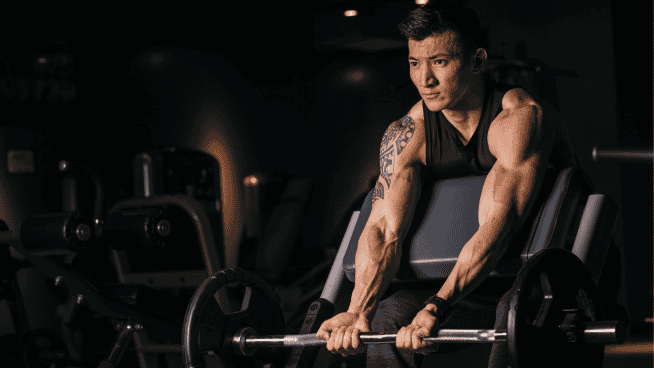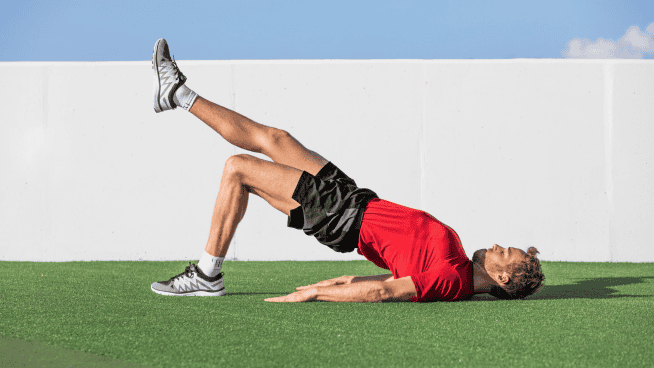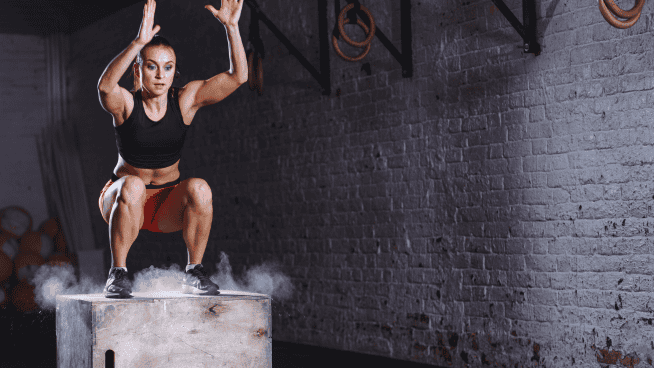Strength Training for Hockey
Our first venture onto the ice yields the best training methods for the fastest game on earth. Grab your stick and meet us at center ice.
Luckily for hockey players, the leader in strength and conditioning and functional training has a penchant for their sport. Mike Boyle spent 17 years as the strength and conditioning coach for the hockey team at Boston University, 10 years as the Boston Bruins’ strength and conditioning coach and a brief stint as director of Athletes’ Performance Los Angeles, before returning in 2004 to his post at BU.
Boyle doesn’t follow strength and conditioning trends; he sets them. His methods center on the functionality of muscles—how they are used in sport. He uses two strategies to improve a hockey player’s functional strength. First and foremost, he emphasizes single-leg strength. Second, he trains movement patterns, not muscles.
Put your opponents on ice by attacking these two under-trained and sometimes overlooked areas of athletic preparation.
SINGLE LEG STRENGTH
According to Boyle, a quality training program emphasizes development of functional lower-body strength—especially single-leg strength, because it is more functional than double-leg strength for any athlete. “All sports are played on one leg,” Boyle says. “And with hockey, massive force and strength are required to turn and corner on one leg. The physics of hockey make a strong case for single-leg versus double-leg training. These guys rarely have two blades in contact with the ice. They are constantly driving and pushing off one leg.”
Boyle says that a single-leg stance forces pelvic stabilizers—muscles in and around the butt, lower back and abdomen— into action. These muscles, which are critical to balance and overall sport performance, are not activated in a two-legged stance. “Balance is single-leg strength,” he asserts.
Boyle’s athletes work power first and lower-body strength second. So after doing their Olympic Lifts, they perform the following functional strength exercises. To increase efficiency and intensity, all lower-body exercises are paired with chin ups or pull-ups.
Single-Leg Squat
• Stand in front of bench or box with one foot on ground and other foot off ground extended forward
• Keeping knee of grounded leg behind toes, squat down to bench or box until thigh is parallel to the ground
• Ascend into starting position
SETS/REPS: 3 x 8-10; decrease reps and gradually increase load every 3 weeks
REST: 60 seconds
LOAD PROGRESSION: Begin with body weight and gradually increase to light dumbbells and a weight vest. Strong athletes can use a 20-pound vest and two 25-35-pound dumbbells for 70-90 pounds of weight.
BOYLE ON THE BENEFITS: The single-leg squat is the most important strength exercise for a hockey player. You work so many more muscles than in a two-legged squat. Since you are balancing on one leg, your hip abductors and adductors, hip flexors, core and small muscles around the ankle all work tremendously hard to maintain balance and stabilize your body through the movement. These are the muscles you use on the ice to maintain balance, change direction and corner.
Slide Board Back Lunge*
• Begin with back foot on slide board and front foot off it
• Keeping front knee behind front toes, slide back foot backwards until back knee almost touches slide board
• Keeping core tight, ascend into start position by performing single-leg squat movement with front leg
* If a slide board is unavailable, perform exercise on a low friction surface such as a gym floor with a towel underneath back foot.
SETS/REPS: 3 x 8-10; decrease reps and gradually increase load every 3 weeks
REST: 60 seconds
LOAD PROGRESSION: Begin with body weight and gradually increase to holding dumbbells
BOYLE ON THE BENEFITS: The Slide Board Back Lunge combines single-leg strength, dynamic flexibility and moderate instability. It is a dynamic exercise, because your feet are not in a static position, but it doesn’t require all the space of a walking lunge.
Conventional lunges work deceleration power, because you stop your forward movement and then push backward. This exercise works acceleration power, because you pull yourself forward.
MOVEMENT PATTERNS
Hockey players should focus on the movement patterns they use on ice rather than working individual muscle groups alone. “People have oversimplified the concept of lower body training,” Boyle says. “You can’t look at training in terms of hamstrings or quads. You have to recognize the existence of different kinds of strength and movement patterns—static patterns, deceleration patterns, acceleration patterns and multi-plane patterns. Each is different and necessary to train to one degree or another.”
HIP EXTENSION
Functional training programs often neglect the most powerful hip extensors—the glutes and hamstrings—focusing instead on knee dominant movements such as flexion and extension. Even worse, according to Boyle, lots of programs “waste time training the hamstrings as knee flexors instead of hip extensors. Athletes do leg curls, which do nothing for hip extension.”
The function of hamstrings and glutes in skating is not flexing the knee but extending the hips. Thus, training them in this movement pattern is necessary.
Single-Leg Stiff-Legged Deadlift
• Stand on one leg and hold light dumbbell in opposite hand
• Keeping back flat, lean forward at waist and lift free leg to the rear in line with torso
• Try to get dumbbell to reach the ground outside of standing leg
• Return to starting position
SETS/REPS: 3 x 8-10 each leg; decrease reps and gradually increase load every 3 weeks
REST: 1 minute
LOAD PROGRESSION: Begin with light dumbbell and gradually increase
BOYLE ON THE BENEFITS: Isolating the glute in the hip extension pattern, although difficult to do, is the best benefit of this drill. You develop your entire posterior chain (glutes and hamstrings) while simultaneously enhancing your balance. Because you are on one leg, work with lighter weight: it is easier on your low back. Also, you receive tremendous proprioceptive work around the ankle when you stabilize on one foot.
Focus the movement on the hip instead of getting the weight to touch the ground. Avoid bending at the waist or side bending.
Slide Board Hamstring Curl*
• Lie on back with soles of feet flat on slide board
• Ascend into bridge position so that knees, hips and shoulders are in straight line
• Without allowing hips to dip, slide feet away from body until legs are straight
• Slide heels back toward buttocks
* If a slide board is unavailable, perform on low friction surface such as a gym floor with a towel underneath both feet.
SETS/REPS: 3 x 8-10
REST: 60 seconds
LOAD PROGRESSION: Strictly body weight
BOYLE ON THE BENEFITS: Conventional leg curls work only one function of the hamstring—knee flexion, which isn’t functional and is never performed in competition. The Slide Board Hamstring Curl trains your hamstring in conjunction with your glute in the hip extension pattern—a more functional motion.
Forcing your hamstring to resist knee flexion when your feet slide back out works the eccentric component. Knee flexion, hip extension and eccentric resistor are functions of the hamstring when your body is in motion.
This exercise is similar to the physioball hamstring curl, but you can be stricter with your form on the slide board. With the physioball version, people have trouble controlling the pelvic action and end up with too much back extension. Initiate the movement from the hips, not the lumbar spine.
Body By Boyle
Boyle says improvements made by the Buffalo Sabres’ hulking forward, Mike Grier, have been most impressive: “When he came to BU, the knock on him was that he wasn’t a good skater. He’s so big. He plays around 235 pounds; and at that weight, you need incredible single-leg strength to do the things you need to do on ice.”
With Boyle’s help, Grier proved his critics wrong, leading his college team to its fourth NCAA Championship in 1995 and becoming a finalist for the Hobey Baker Award. Boyle adds, “Grier became an NHL-caliber skater and player as a result of this training.”
In addition to his duties in the NHL, Grier played for the United States in the 2004 World Championships in Prague, Czech Republic, where he was instrumental in Team USA’s bronze-medal performance.
The Right Way
Boyle knows that many strength-training mistakes are widespread. “High school kids make the same mistakes over and over again,” he says. “You see guys who lift too much weight too fast with lousy technique. We emphasize mastery. Concentrate on mastering your technique first, and then worry about the load.”
Here are two of Boyle’s guidelines for proper strength training technique:
Speed of movement
Use a 3:1 tempo for speed of movement: a three-count on the eccentric phase of the lift and a one-count on the concentric phase. For example, when benching, lower the bar to your chest for a three-count and press the bar up for a one-count.
Core Matters
Maintaining a tight core is crucial for all exercises. Avoid bending at the waist or side, especially in hip extension exercises.
RECOMMENDED FOR YOU
MOST POPULAR
Strength Training for Hockey
Our first venture onto the ice yields the best training methods for the fastest game on earth. Grab your stick and meet us at center ice.
Luckily for hockey players, the leader in strength and conditioning and functional training has a penchant for their sport. Mike Boyle spent 17 years as the strength and conditioning coach for the hockey team at Boston University, 10 years as the Boston Bruins’ strength and conditioning coach and a brief stint as director of Athletes’ Performance Los Angeles, before returning in 2004 to his post at BU.
Boyle doesn’t follow strength and conditioning trends; he sets them. His methods center on the functionality of muscles—how they are used in sport. He uses two strategies to improve a hockey player’s functional strength. First and foremost, he emphasizes single-leg strength. Second, he trains movement patterns, not muscles.
Put your opponents on ice by attacking these two under-trained and sometimes overlooked areas of athletic preparation.
SINGLE LEG STRENGTH
According to Boyle, a quality training program emphasizes development of functional lower-body strength—especially single-leg strength, because it is more functional than double-leg strength for any athlete. “All sports are played on one leg,” Boyle says. “And with hockey, massive force and strength are required to turn and corner on one leg. The physics of hockey make a strong case for single-leg versus double-leg training. These guys rarely have two blades in contact with the ice. They are constantly driving and pushing off one leg.”
Boyle says that a single-leg stance forces pelvic stabilizers—muscles in and around the butt, lower back and abdomen— into action. These muscles, which are critical to balance and overall sport performance, are not activated in a two-legged stance. “Balance is single-leg strength,” he asserts.
Boyle’s athletes work power first and lower-body strength second. So after doing their Olympic Lifts, they perform the following functional strength exercises. To increase efficiency and intensity, all lower-body exercises are paired with chin ups or pull-ups.
Single-Leg Squat
• Stand in front of bench or box with one foot on ground and other foot off ground extended forward
• Keeping knee of grounded leg behind toes, squat down to bench or box until thigh is parallel to the ground
• Ascend into starting position
SETS/REPS: 3 x 8-10; decrease reps and gradually increase load every 3 weeks
REST: 60 seconds
LOAD PROGRESSION: Begin with body weight and gradually increase to light dumbbells and a weight vest. Strong athletes can use a 20-pound vest and two 25-35-pound dumbbells for 70-90 pounds of weight.
BOYLE ON THE BENEFITS: The single-leg squat is the most important strength exercise for a hockey player. You work so many more muscles than in a two-legged squat. Since you are balancing on one leg, your hip abductors and adductors, hip flexors, core and small muscles around the ankle all work tremendously hard to maintain balance and stabilize your body through the movement. These are the muscles you use on the ice to maintain balance, change direction and corner.
Slide Board Back Lunge*
• Begin with back foot on slide board and front foot off it
• Keeping front knee behind front toes, slide back foot backwards until back knee almost touches slide board
• Keeping core tight, ascend into start position by performing single-leg squat movement with front leg
* If a slide board is unavailable, perform exercise on a low friction surface such as a gym floor with a towel underneath back foot.
SETS/REPS: 3 x 8-10; decrease reps and gradually increase load every 3 weeks
REST: 60 seconds
LOAD PROGRESSION: Begin with body weight and gradually increase to holding dumbbells
BOYLE ON THE BENEFITS: The Slide Board Back Lunge combines single-leg strength, dynamic flexibility and moderate instability. It is a dynamic exercise, because your feet are not in a static position, but it doesn’t require all the space of a walking lunge.
Conventional lunges work deceleration power, because you stop your forward movement and then push backward. This exercise works acceleration power, because you pull yourself forward.
MOVEMENT PATTERNS
Hockey players should focus on the movement patterns they use on ice rather than working individual muscle groups alone. “People have oversimplified the concept of lower body training,” Boyle says. “You can’t look at training in terms of hamstrings or quads. You have to recognize the existence of different kinds of strength and movement patterns—static patterns, deceleration patterns, acceleration patterns and multi-plane patterns. Each is different and necessary to train to one degree or another.”
HIP EXTENSION
Functional training programs often neglect the most powerful hip extensors—the glutes and hamstrings—focusing instead on knee dominant movements such as flexion and extension. Even worse, according to Boyle, lots of programs “waste time training the hamstrings as knee flexors instead of hip extensors. Athletes do leg curls, which do nothing for hip extension.”
The function of hamstrings and glutes in skating is not flexing the knee but extending the hips. Thus, training them in this movement pattern is necessary.
Single-Leg Stiff-Legged Deadlift
• Stand on one leg and hold light dumbbell in opposite hand
• Keeping back flat, lean forward at waist and lift free leg to the rear in line with torso
• Try to get dumbbell to reach the ground outside of standing leg
• Return to starting position
SETS/REPS: 3 x 8-10 each leg; decrease reps and gradually increase load every 3 weeks
REST: 1 minute
LOAD PROGRESSION: Begin with light dumbbell and gradually increase
BOYLE ON THE BENEFITS: Isolating the glute in the hip extension pattern, although difficult to do, is the best benefit of this drill. You develop your entire posterior chain (glutes and hamstrings) while simultaneously enhancing your balance. Because you are on one leg, work with lighter weight: it is easier on your low back. Also, you receive tremendous proprioceptive work around the ankle when you stabilize on one foot.
Focus the movement on the hip instead of getting the weight to touch the ground. Avoid bending at the waist or side bending.
Slide Board Hamstring Curl*
• Lie on back with soles of feet flat on slide board
• Ascend into bridge position so that knees, hips and shoulders are in straight line
• Without allowing hips to dip, slide feet away from body until legs are straight
• Slide heels back toward buttocks
* If a slide board is unavailable, perform on low friction surface such as a gym floor with a towel underneath both feet.
SETS/REPS: 3 x 8-10
REST: 60 seconds
LOAD PROGRESSION: Strictly body weight
BOYLE ON THE BENEFITS: Conventional leg curls work only one function of the hamstring—knee flexion, which isn’t functional and is never performed in competition. The Slide Board Hamstring Curl trains your hamstring in conjunction with your glute in the hip extension pattern—a more functional motion.
Forcing your hamstring to resist knee flexion when your feet slide back out works the eccentric component. Knee flexion, hip extension and eccentric resistor are functions of the hamstring when your body is in motion.
This exercise is similar to the physioball hamstring curl, but you can be stricter with your form on the slide board. With the physioball version, people have trouble controlling the pelvic action and end up with too much back extension. Initiate the movement from the hips, not the lumbar spine.
Body By Boyle
Boyle says improvements made by the Buffalo Sabres’ hulking forward, Mike Grier, have been most impressive: “When he came to BU, the knock on him was that he wasn’t a good skater. He’s so big. He plays around 235 pounds; and at that weight, you need incredible single-leg strength to do the things you need to do on ice.”
With Boyle’s help, Grier proved his critics wrong, leading his college team to its fourth NCAA Championship in 1995 and becoming a finalist for the Hobey Baker Award. Boyle adds, “Grier became an NHL-caliber skater and player as a result of this training.”
In addition to his duties in the NHL, Grier played for the United States in the 2004 World Championships in Prague, Czech Republic, where he was instrumental in Team USA’s bronze-medal performance.
The Right Way
Boyle knows that many strength-training mistakes are widespread. “High school kids make the same mistakes over and over again,” he says. “You see guys who lift too much weight too fast with lousy technique. We emphasize mastery. Concentrate on mastering your technique first, and then worry about the load.”
Here are two of Boyle’s guidelines for proper strength training technique:
Speed of movement
Use a 3:1 tempo for speed of movement: a three-count on the eccentric phase of the lift and a one-count on the concentric phase. For example, when benching, lower the bar to your chest for a three-count and press the bar up for a one-count.
Core Matters
Maintaining a tight core is crucial for all exercises. Avoid bending at the waist or side, especially in hip extension exercises.










